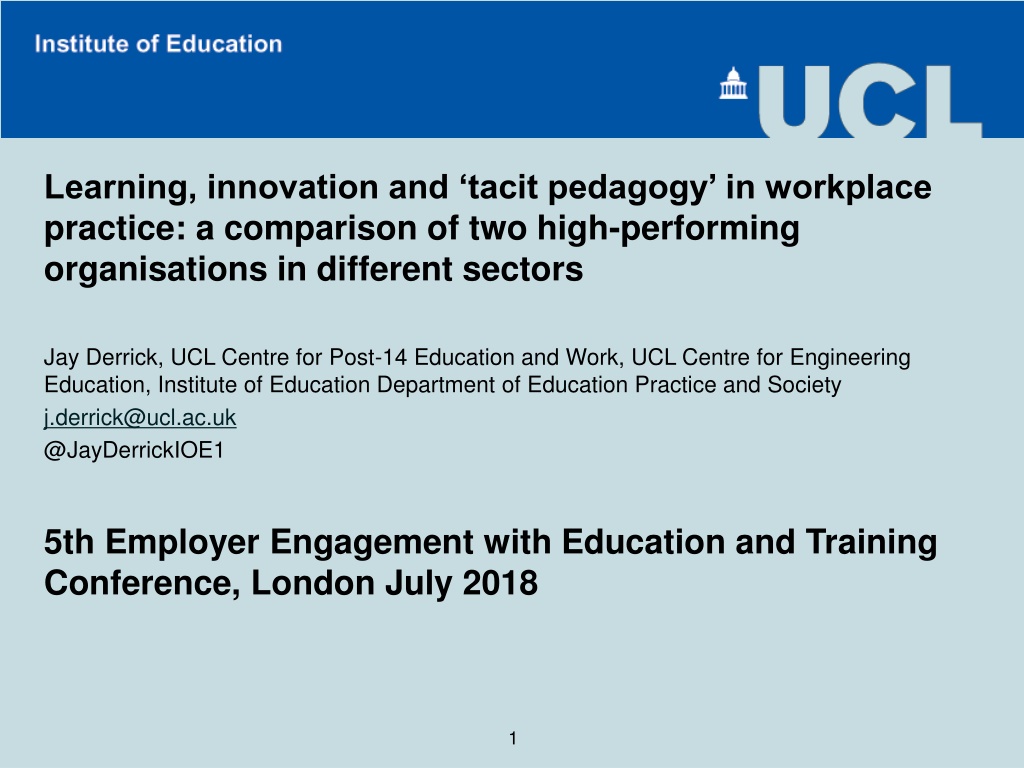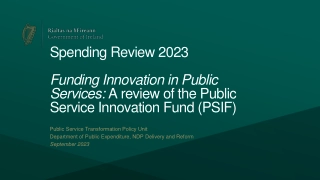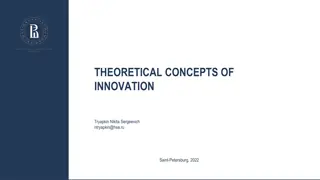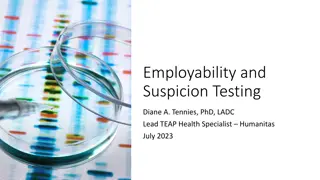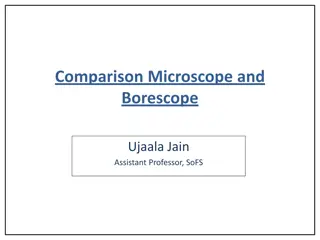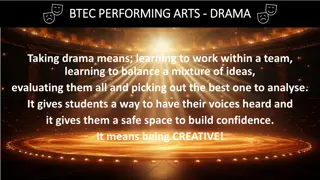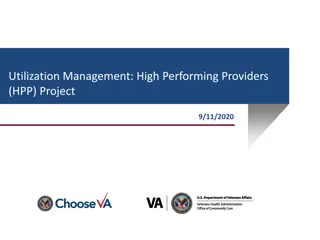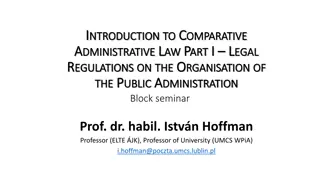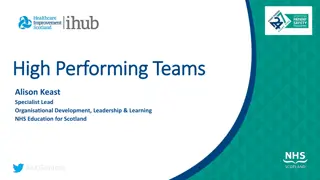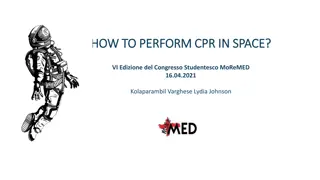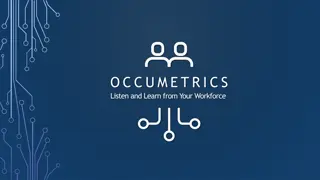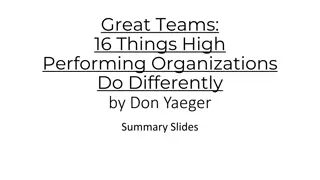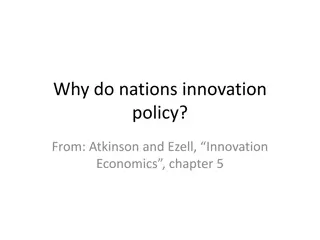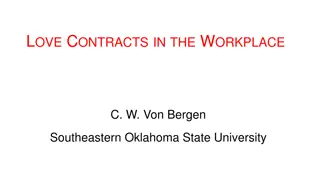Comparison of Workplace Learning and Innovation in High-Performing Organizations
This study compares workplace learning and innovation in two high-performing organizations in different sectors, focusing on informal elements such as tacit pedagogy. It explores conditions supporting learning and innovation, team-working practices, and external factors affecting innovation. The study emphasizes the importance of tacit skills and the need for adaptation in uncertain environments.
Download Presentation

Please find below an Image/Link to download the presentation.
The content on the website is provided AS IS for your information and personal use only. It may not be sold, licensed, or shared on other websites without obtaining consent from the author. Download presentation by click this link. If you encounter any issues during the download, it is possible that the publisher has removed the file from their server.
E N D
Presentation Transcript
Learning, innovation and tacit pedagogy in workplace practice: a comparison of two high-performing organisations in different sectors Jay Derrick, UCL Centre for Post-14 Education and Work, UCL Centre for Engineering Education, Institute of Education Department of Education Practice and Society j.derrick@ucl.ac.uk @JayDerrickIOE1 5th Employer Engagement with Education and Training Conference, London July 2018 1
Workplaces as sites for learning and innovation Dimensions of change affecting workplaces Outline of the study Conceptual frameworks used Findings: conditions in work environments supporting learning and innovation Key team-working practices Findings: external conditions for innovation Illustrative quotations from the data Selected references 2
Workplaces as sites for learning The role of informal, tacit and social elements of the workplace environment, for better or worse, in production, learning and organisational development: tacit pedagogy Learning: May be accidental, rather than planned Often incidental or oblique to formal work practice May be unconscious Is embodied and affective, not just cerebral Usually no formal teacher Usually no formal assessment or qualification 3
Dimensions of uncertainty: Technological development (eg digital communication, automated systems, big data, platform capitalism) Social and economic change (eg increasing inequality, social and political instability, changing communities, migration) Macro-context shifts (eg globalization, climate change) Increasing politicisation of professional work contexts (eg performativity, risk, audit and accountability) Indispensable elements of practice, whatever the context, are based on tacit skills, knowledge and expertise (ie uncodifiable and uncertain) Any change in the environment means learning and/or innovation is required: recontextualisation (Guile 2014) Importance of capacity to adapt, learn, innovate 4
This study: Comparison of two high-performing organisations in different domains, both partly public-funded: TLZ R&D broadcast engineering, global reputation WBC further education college rated outstanding by OFSTED Focus of the study: the informal features of organisational culture, work processes and strategic orientation that support innovation how these relate to organisational structures, policies and procedures how learning, innovation and practice are interrelated conceptually and practically Qualitative data collected through interviews and focus groups with teams of practitioners in each organisation (n=24, 14 in WBC, 10 in TLZ R&D) Informed by literatures on organisational development, workplace learning, and innovation Carried out as part of a UCL Institute of Education Ed D 5
Research questions: How do practitioners in high-performing organisations make use of informal modes of learning and team-working to support innovation? What informal features of organisational culture, work processes and strategic orientation support innovation in two high performing organisations? How do these features interrelate with formal features of these organisations? How are learning, innovation and practice interrelated conceptually? 6
Main conceptual frameworks used: Organisational learning and innovation (Brown and Duguid 1991) Standard and Emergent paradigms of learning (Beckett and Hager 2002) Expansive-Restrictive Continuum (Fuller and Unwin 2004) Activity theory (eg Engestr m 2011) Productive systems (Felstead et al 2009) Reconceptualisation (Guile 2014) 7
Conditions for learning and innovation: findings #1 Motivation High standards, reputation of organisation, pride in expertise and quality of work Trust Shared commitment to overall mission and strategic direction Public purpose: worthwhileness of the work, benefits to society Project team working Challenging, swampy problems (Sch n 1983) Autonomous: teams design and adapt their own work processes Different disciplinary expertise, different levels of experience Collaborative, communicative, social Expectation to share rather than hoard knowledge Expansive team leadership (Fuller and Unwin 2004) 8
Conditions for learning and innovation: findings #2 Team-work processes Writing-up Notes, memos, technotes , reports, papers These are all provisional representations of aspects of work For sharing, consultation and peer review Peer review Evaluation, debating, checking, feedback, suggestions for improvement Boundary crossing (Akkerman and Bakker 2011) Specialisms, teams, departments, organisations Artefacts used as medium of collaboration and mutual understanding Organisational environment Culture: norms of team-working, socialising and sharing ideas as part of work Facilities: kit, social spaces, communicative tools, networks Opportunity: time, particularly for processes above Clear mission and strategic direction 9
Team-working practices: findings #3 Writing-up All sorts of formats, depending on the particular domain of practice Consists of any provisional representation of work content and processes Some shared with close peers and/or wider colleagues and networks Peer review Evaluation, feedback and/or development of representations Engaging with ideas across specialisms involves learning The development of ideas is moved forward Boundary crossing Specialisms Teams, divisions, organisations Cultures, languages Use of artefacts as mediating tools for boundary crossing (Engestr m 2011) NB: Formal use of these processes are the tip of the iceberg: mostly used informally 10
Conditions for learning and innovation: findings #4 Significance of Productive systems (Felstead et al 2009) within which organisations operate, supporting or inhibiting work processes designed to foster innovativeness Funding systems Outcome requirements Quality assurance frameworks Legal frameworks Policy frameworks Instability, unpredictability These factors influence but do not determine how organisations develop. High stakes and highly-specified compliance systems restrict organisations freedom and space to design their own work processes, limiting opportunities for specialist practitioners to work innovatively 11
An important trait to foster innovation is transparency, passing on of information and knowledge, rather than hoarding information and knowledge. Some people see knowledge as power and use it as a means of controlling other people, but that is a barrier to effective innovation, what you want is for information to flow freely. (TLZ engineer) We are deemed in the college to be a very good team, so hopefully that s some of my inputs. You haven t always got the answers: these guys are coming up with fresh ideas and innovative stuff, and you think yeah, let s go with it. I think that s why it works, because they are given their own head, it s not just me telling them. (WBC teacher) People from different organisations and backgrounds we have no idea of, with perhaps an interest in technology, can provide feedback. And the reason that s useful is because, you know, it s crowdsourcing the problem. (TLZ engineer) I ve got my logbook full of low level details, I established some level of understanding, able to write about that a bit more clearly, pass that around, then at some point decide to put these questions onto the project wiki myself. (TLZ engineer) we are pretty much left to our own business .as long as they don t get too much grief from above they let you get on with it . (WBC teacher) 12
Its a formal thing we do in our team meetings when we exchange information, but actually informal opportunities for serendipitous exchanges really are extremely powerful, and every good academic research group has got its coffee room. (TLZ engineer) if we ve got work to do there s a few of us who stay late, and we order food in and go to the gym and things, so I feel it s a very social environment, often I don t feel like I m doing work, I feel like I m just hanging out with my friends. (WBC teacher) Nobody s micro-managing me, individual autonomy, that s the key thing I ve noticed in the team. (WBC teacher) I just happened to bump into a colleague on the stairs one day and a three minute conversation became a ten minute conversation that became a half hour meeting that became a project. (TLZ engineer) Recently we took our kit into a BT lab and they have lab conditions there that are different from lab conditions that we have, and by just taking it into that different milieu, and you think actually what I really need to do is work on this little thing that we don t experience in our environment, and it s a slightly different take on things. (TLZ engineer) 13
teams get to know each other and self-organise in a way so that when a challenge or task comes up they are able to arrange themselves into a solution, rather than having to be heavily structured and told how to do that - the team leader role becomes more about managing it. (TLZ engineer) The learning is as much from what other people in the same organisation have written before, you re standing on their shoulders. That s why writing up is so important. It s part of building that co-operative, collaborative culture, writing up all the time. (TLZ engineer) there s no way you can be innovative in isolation, it s all about collaboration. (TLZ engineer) the college wanted a whole week s induction, which is, for our type of learner, just too full-on. The new students don t like it, you know, because they want to work on cars. So we are shortening the induction, getting them onto the cars quite early, and then put in some of the stuff they may not be so keen on later. We found that if we did the metal task [too early] that could switch them off a bit (WBC teacher) 14
References: Akkerman, S. and Bakker, A. (2011). Boundary crossing and boundary objects. Review of Educational Research 81 (2), pp 132 169 Beckett, D. and Hager, P. (2002). Life, Work and Learning: Practice in Postmodernity. London: Routledge Brown, J.S., and Duguid, P. (1991). Organisational Learning and Communities of Practice: Towards a Unified View of Working, Learning and Innovation. Organization Science 2 (1), pp 40-57 Engestrom, Y. (2011). Activity theory and Learning at Work. In Malloch, M., Cairns, L., Evans, K., and O Connor, B. (Eds), The Sage Handbook of Workplace Learning. London: Sage pp86-104 Felstead, A., Fuller, A., Jewson, N. and Unwin, L. (2009). Improving Working as Learning. London: Routledge Fuller, A. and Unwin, L. (2004). 'Expansive learning environments - integrating organisational and personal development', in Rainbird H., Fuller A. and Munro A. (Eds) Workplace Learning in Context. London: Routledge pp126-144 Guile, D. (2014). Professional knowledge and professional practice as continuous recontextualisation: a social practice perspective. In Young, M. and Muller, J. (eds), Knowledge, Expertise and the Professions. London: Routledge Sch n, D. (1983). The Reflective Practitioner: how professionals think in action. Aldershot: Ashgate Publishing Ltd 15
